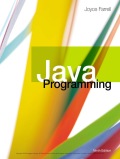
Concept explainers
Explanation of Solution
a.
Program code:
Sandwich.java
//create a class Sandwitch
public class Sandwich
{
//create string variables
private String ingredient, breadType;
//create double variable
private double price;
//define a constructor
public Sandwich()
{
}
//define a method getIngredient()
public String getIngredient()
{
//return the ingredient
return ingredient;
}
//define a method setIngredient()
public void setIngredient(String ingredient)
{
//set value of the variable ingredient
this.ingredient = ingredient;
}
//define a method getBreadType()
public String getBreadType()
{
//return the breadType
return breadType;
}
//define a method setBreadType()
public void setBreadType(String breadType)
{
//set value of the variable breadType
this.breadType = breadType;
}
//define a method getPrice()
public double getPrice()
{
//return the price
return price;
}
//define a method setPrice()
public void setPrice(double price)
{
//set value of the variable price
this.price = price;
}
}
Explanation:
The above snippet of code is used create a class “Sandwich”. The class contain different static methods for store the details of sandwich. In the code,
- Define a class “Sandwich”
- Define the constructor “Sandwich()” method.
- Define the “getIngredient()” method.
- Return the value of the variable “ingredient”.
- Define the “setIngredient()” method.
- Set the value of the variable “ingredient”.
- Define the “getBreadType()” method.
- Return the value of the variable “breadType”.
- Define the “setBreadType ()” method...
Trending nowThis is a popular solution!

Chapter 3 Solutions
EBK JAVA PROGRAMMING
- Write a FancyCar class to support basic operations such as drive, add gas, honk horn, and start engine. FancyCar.java is provided with method stubs. Follow each step to gradually complete all methods. Note: This program is designed for incremental development. Complete each step and submit for grading before starting the next step. Only a portion of tests pass after each step but confirm progress. The main() method includes basic method calls. Add statements in main() as methods are completed to support development mode testing. Step 0. Declare private fields for miles driven as shown on the odometer (int), gallons of gas in tank (double), miles per gallon or MPG (double), driving capacity (double), and car model (String). Note the provided final variable indicates the gas tank capacity of 14.0 gallons. Step 1 (2 pts). 1) Complete the default constructor by initializing the odometer to five miles, tank is full of gas, miles per gallon is 24.0, and the model is "Old Clunker". 2)…arrow_forwardFind the error: daily_sales = [0.0, 0.0, 0.0, 0.0, 0.0, 0.0, 0.0] days_of_week = ['Sunday', 'Monday', 'Tuesday', 'Wednesday', 'Thursday', 'Friday', 'Saturday'] for i in range(7): daily_sales[i] = float(input('Enter the sales for ' \ + day_of_week[i] + ': ')arrow_forwardFind the error: daily_sales = [0.0, 0,0, 0.0, 0.0, 0.0, 0.0, 0.0] days_of_week = ['Sunday', 'Monday', 'Tuesday', 'Wednesday', 'Thursday', 'Friday', 'Saturday'] for i in range(7): daily_sales[i] = float(input('Enter the sales for ' \ + days_of_week[i] + ': ')arrow_forward
- Find the error: daily_sales = [0.0, 0.0, 0.0, 0.0, 0.0, 0.0, 0.0] days_of_week = ['Sunday', 'Monday', 'Tuesday', 'Wednesday', 'Thursday', 'Friday', 'Saturday'] for i in range(6): daily_sales[i] = float(input('Enter the sales for ' \ + days_of_week[i] + ': '))arrow_forwardWhat are the steps you will follow in order to check the database and fix any problems with it and normalize it? Give two references with your answer.arrow_forwardWhat are the steps you will follow in order to check the database and fix any problems with it? Have in mind that you SHOULD normalize it as well. Consider that the database offline is not allowed since people are connected to it and personal data might be bridged and not secured. Provide three refernces with you answer.arrow_forward
- Should software manufacturers should be tolerant of the practice of software piracy in third-world countries to allow these countries an opportunity to move more quickly into the information age? Why or why not?arrow_forwardI would like to know about the features of Advanced Threat Protection (ATP), AMD-V, and domain name space (DNS).arrow_forwardPlease show the code for the Tikz figurearrow_forward
 EBK JAVA PROGRAMMINGComputer ScienceISBN:9781337671385Author:FARRELLPublisher:CENGAGE LEARNING - CONSIGNMENTProgramming Logic & Design ComprehensiveComputer ScienceISBN:9781337669405Author:FARRELLPublisher:Cengage
EBK JAVA PROGRAMMINGComputer ScienceISBN:9781337671385Author:FARRELLPublisher:CENGAGE LEARNING - CONSIGNMENTProgramming Logic & Design ComprehensiveComputer ScienceISBN:9781337669405Author:FARRELLPublisher:Cengage EBK JAVA PROGRAMMINGComputer ScienceISBN:9781305480537Author:FARRELLPublisher:CENGAGE LEARNING - CONSIGNMENT
EBK JAVA PROGRAMMINGComputer ScienceISBN:9781305480537Author:FARRELLPublisher:CENGAGE LEARNING - CONSIGNMENT Microsoft Visual C#Computer ScienceISBN:9781337102100Author:Joyce, Farrell.Publisher:Cengage Learning,
Microsoft Visual C#Computer ScienceISBN:9781337102100Author:Joyce, Farrell.Publisher:Cengage Learning, Programming with Microsoft Visual Basic 2017Computer ScienceISBN:9781337102124Author:Diane ZakPublisher:Cengage Learning
Programming with Microsoft Visual Basic 2017Computer ScienceISBN:9781337102124Author:Diane ZakPublisher:Cengage Learning




